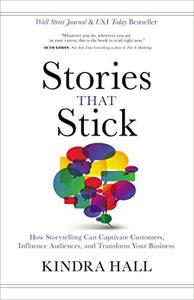
Want to learn the ideas in Stories That Stick better than ever? Read the world’s #1 book summary of Stories That Stick by Kindra Hall here.
Read a brief 1-Page Summary or watch video summaries curated by our expert team. Note: this book guide is not affiliated with or endorsed by the publisher or author, and we always encourage you to purchase and read the full book.
Video Summaries of Stories That Stick
We’ve scoured the Internet for the very best videos on Stories That Stick, from high-quality videos summaries to interviews or commentary by Kindra Hall.
1-Page Summary of Stories That Stick
Stories help you bridge the gap between your product or service and your targeted audience.
Every business needs to profit and deliver a valuable product or service. This isn’t easy, because there are many factors that can make it hard for a business to succeed. Even Extra gum, which is one of the most popular brands in the world, faced lagging sales at some point. However, they turned this around by creating an ad campaign based on a love story between two people who share their first piece of gum together. The video received 100 million views online and showed how storytelling can be used as part of effective marketing strategies.
To be successful, your story needs to have three elements:
You don’t have to take attention away from people. People give it freely if the subject is worthwhile. Stories are co-creations, in which the teller guides listeners by telling them what’s happening and asking questions that make listeners fill in the gaps with their own experiences and emotions.
Influential people are able to persuade others. They use stories that change the way other people think and act, as well as those who hear them. For example, John Fitzgerald Kennedy met a perfumer in France named Albert Fouquet. Fouquet gave him samples of his cologne, which he liked so much that he asked for more for himself and one for his brother Robert Kennedy. He even wrote to Fouquet asking him to send eight more bottles of it back home with a note saying “one is for Bob”. The perfume was called Eight & Bob and became very popular among distinguished men around the world because of its great scent and story behind it.
Hearing effective stories releases neurochemicals that make people more open and generous.
Since stories trigger the body’s production of oxytocin, a neurochemical that increases empathy, telling good stories makes your audience more receptive and trusting. The brain also produces attention-boosting cortisol, as well as dopamine, which rewards action with a sense of pleasure. When you tell your story in this way, it will be easier to bond people together and elicit generosity from them.
The Maricopa Health Foundation needed to make this year’s annual charity ball better than last year’s to raise money for its hospital. To do that, the Center focused on personal stories about how the hospital helped people in need and connected them with one another. This resulted in a lot of donations from attendees at the event.
Stories make people like each other and are a part of what makes us human. Humans evolved to be cooperative because they could share stories, which help them understand the world around them and create meaning. Stories allow people to imagine things that aren’t there, which helps them achieve their dreams.
Telling an effective story is easier than you think, but it needs structure.
Many businesses confuse branding with stories. A list of ingredients or a mission statement is not a story. Stories follow four necessary components: 1. Identifiable characters – Build the story around people that your audience can relate to, 2. Authentic emotion – The characters’ feelings should elicit similar emotions in the audience, 3. Significant moment – The story has a pivotal point when something important happens that transforms the audience’s experience and 4 Specific details – Interesting specifics spark listeners’ imagination and take them to the place and time of the story.
A meaningful “Value Story” shifts the focus to customers’ needs and how you can fulfill them.
Workiva helps companies save money by improving their business processes. However, many customers are reluctant to change because they’re comfortable with the status quo. To help close that gap between customer needs and Workiva’s product, sales reps tell a story about how one company saved time and improved accuracy by using Workiva. The result was happier employees and more accurate reporting for the company.





